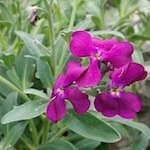Matthiola incana
Hoary stock, gillyflowers Βιολέτα, μαντιά

Cruciferae - the mustard family Dicot.
Matthiola incana
Hoary stock, gillyflowers Βιολέτα, μαντιά

Cruciferae - the mustard family Dicot.
Matthiola incana, with its striking purple flowers and grey-green foliage, is only one of many brilliantly coloured flowers which brighten the rocks and walls in early summer; it is always found close to the sea. Although it grows wild on Skopelos, Mathiola incana has been cultivated since ancient times; it was described by Theophrastus as a coronary plant (στεφανωμάτων); he noted that it as the first to appear. It was used for making garlands and valued for its scent and variety of colour.
All the M. Incana flowers on the island are purple but petals of many of the flowers in the Aghios Yiannis area are streaked with white, probably as a result of infection with a mosaic virus. None of the flower in the Skopelos town area have similar streaks.

Gillyflowers
The cultivation of flowers for their fragrance and beauty can be traced back to ancient times. Mathiola incana was described by Theophrastus as a coronary plant; it was used for making garlands and valued for its scent and variety of colour.

The romantic name, gillyflower, has been used in England to describe M. Incana since the Middle Ages, probably deriving from the French, Giroflèe, the word for clove and refers to the spicy scent of the flower. The gillyflower of the time were the beautifully, simple, cruciferous form, as illustrated in the 15th Century woodcut, not the blousy varieties grown as garden stocks today1.
2
M. Incana is not the only flower to be given the name gillyflower it was used for other flowers: the pink, Dianthus caryophyllus and the wallflower, Cheiranthus cheiri. It was used, also as a general term for any attractive scented flower and in Elizabethan England "gillyflower gardens" were popular; they were filled with fragrant flowers carnations, pinks, stocks and wallflowers.
1. THEOPHRASTUS. ENQUIRY INTO PLANTS. Vol. I & II. Translated by A.F.Hort. Loeb Classics. Harvard University Press.
2.This picture was taken from Dictionnaire encyclopédique Trousset, also known as the Trousset encyclopedia, Paris, 1886 - 1891. oldbookillustrations.com



